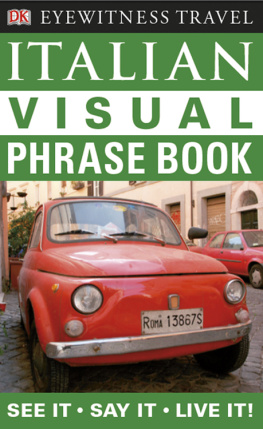The

European Travel Phrase Book
A Bundle of Spanish, Italian, French, and German Translations
The Everything Series Editors

Avon, Massachusetts
Copyright 2010 by F+W Media, Inc.
epub eISBN 10: 1-4405-1258-2
epub eISBN 13: 978-1-4405-1258-2
pdf eISBN 10: 1-4405-1259-0
pdf eISBN 13: 978-1-4405-1259-9
Contains material adapted and abridged from The EverythingSpanish Phrase Book, by Cari Luna, copyright 2004 by F+W Media Inc., ISBN 10: 1-4405-0505-5, ISBN 13: 978-1-4405-0505-8; The EverythingFrench Phrase Book, by Laura K. Lawless, copyright 2005 by F+W Media Inc., ISBN 10: 1-59337-144-6, ISBN 13: 978-1-59337-144-9; The EverythingItalian Phrase Book, by Ronald Glenn Wrigley, M.A., copyright 2009 by F+W Media Inc., ISBN 10: 1-59869-756-0, ISBN 13: 978-1-59869-756-8; The EverythingGerman Phrase Book, by Edward Swick, M.A., copyright 2009 by F+W Media Inc., ISBN 10: 1-59869-755-2, ISBN 13: 978-1-59869-755-1.
Table of Contents
Spanish
Italian
French
German
With Europe's cheap airfare and rail system, many travelers are visiting more and more of Europe. To enhance your time in Barcelona, Paris, Florence, Berlin, and other exciting European cities, you should have a basic understanding of the language spoken there.
This book is an easy-to-use resource that can be utilized as a quick refresher or reference guide for Spanish, Italian, French, and German. For those looking to brush up on their language skills or start a conversation, the book offers an introduction to pronunciation and grammar, which will aid you in constructing basic, natural sounding sentences. Transliteration charts will help you pronounce each vocabulary word and phrase properly and with ease. Also, the thematic organization of the book makes it simple to find the information you're looking for and covers all the subjects you are likely to encounter in your travelsfrom reserving a hotel room or ordering dinner at a restaurant to using a cell phone or changing a flight.
Having The EverythingEuropean Travel Phrase Book right at your fingertips will give you the confidence you need to explore those places off the beaten path that few travelers ever visit. You will discover the world's gems, learn interesting new facts, handle unexpected situations, and certainly make the most of your stay!
Happy travels! Buen viaje! Bon voyage! Buon viaggio! Gute Reise!
This chapter is by no means intended to replace formal Spanish instruction or a Spanish textbook. What it will give you is a basic understanding of Spanish pronunciation and grammar, to put the phrases you'll find later in the book into a framework. We hope that this basic introduction will serve you well as you explore the rest of this book. In the next chapter, we jump right into conversation. Buena suerte! Good luck!
A Guide to Pronunciation
Spanish isn't a difficult language to pronounce. Just remember to relax your mouth and use your lips. We don't really use our lips all that much in English, but you'll need them in Spanish, so don't be afraid to put them out there!
The great thing about Spanish pronunciation is that it sounds exactly the way it's spelled. In English, car and cat have two different vowel sounds in spite of their similar spellings. In Spanish, the letter a always represents one particular sound.
Even more conveniently, there are two simple rules that govern which syllable in any word is normally accented:
In words that end in a vowel (a, e, i, o, u), s, or n, the stress normally falls on the second-to-last syllable. For example: mano (MAH-noh), hand; playas (PLAH-yahs), beaches; cantaban (kahn-TAH-bahn), they sang.
In words that end in any consonant except s or n, the stress normally falls on the last syllable. For example: verdad (vehr-DAHD), truth; azul (ah-SOOL), blue; luz (loos), light.
However, some words don't follow these two rules. To let the readers know how these words should be stressed in pronunciation, Spanish employs an acute accent mark ( ) over the vowel to indicate the stressed syllable. For example: lpiz (LAH-pees), pencil; mdico (MEH-dee-coh), doctor; msica (MOO-see-kah), music. The accent mark might also be used to differentiate two words with same spelling but different meaning: dnde (DOHN-deh), where (question word); donde (DOHN-deh), where (as a preposition).
The Pronunciation Guide chart will certainly help you with pronunciation, but nothing works as well as getting the sound of the language in your ear. To learn to pronounce Spanish words, listen to the spoken language. Listening to Spanish on TV, the radio, or the city bus will get your ear accustomed to the sounds, and you'll find it much easier to recreate them yourself.
Pronunciation Guide
| Letter | Sound | Example | Pronunciation |
| a | ah | ala (wing) | AH-la |
| b | b | bolsa (bag) | BOHL-sah |
| c | s before i, e; | centro (center) | SEHN-troh |
| k in all other cases | casa (house) | KAH-sah |
| ch | ch | coche (car) | KOH-cheh |
| d | d | dedo (finger) | DEH-do |
| e | eh | estar (to be) | eh-STAHR |
| f | f | falso (false) | FAHL-soh |
| g | a hard | gente (people), | HEHN-the |
| h sound before e, i; a hard g sound in all other cases | gracias (thanks) | GRAH-see-ahs |
| h | silent | hola (hi) | OH-lah |
| i | ee | igual (equal) | ee-GWAHL |
| j | a hard h | jabn (soap) | hah-BOHN |
| k | k in words | kilo (kilogram) | KEE-loh |
| of foreign origin |
| l | l | lado (side) | LAH-doh |
| ll | y | llamar (to call) | yah-MAHR |
| m | m | muy (very) | mui |
| n | n | nunca (never) | NUHN-kah |
| ny | maana | mah-NYAH-nah |
| (tomorrow) |
| o | oh | ojo (eye) | OH-hoh |
| p | p | pelo (hair) | PEH-loh |
| q | k | quince (fifteen) | KEEN-seh |
| r | a hard r | radio (radio) | RAH-dee-oh |
| rr | a rolled r | perro (dog) | PEH-rroh |
| s | s | sol (sun) | sohl |
| t | t | todo (all) | TOH-doh |
| u | oo | til (useful) | OO-tihl |
| v | v | vivo (alive) | VEE-voh |
| w | w in words of foreign origin | whisky (whisky) | WEES-kih |
| x | ks | xito (success) | EHKS-ee-toh |












